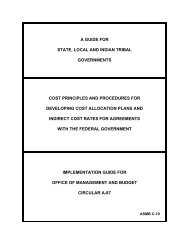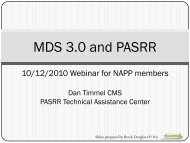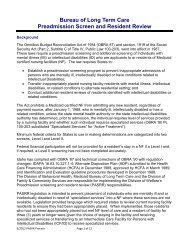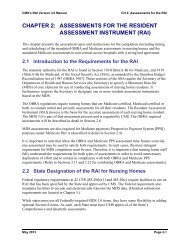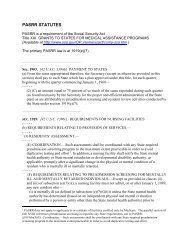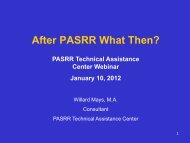10% - PASRR Technical Assistance Center
10% - PASRR Technical Assistance Center
10% - PASRR Technical Assistance Center
You also want an ePaper? Increase the reach of your titles
YUMPU automatically turns print PDFs into web optimized ePapers that Google loves.
SHOW - ME<br />
Integration of Behavioral<br />
Health and Primary Care
My Background<br />
• DMH Medical Director<br />
• Consultant to MoHealthNet (Missouri Medicaid)<br />
• President NASMHPD Medical Director’s Council<br />
• Practicing FQHC Psychiatrist<br />
• Director Missouri Institute of Mental Health –<br />
University of Missouri St Louis
National Association of State Mental<br />
Health Program Directors (NASMHPD)<br />
• Membership is the Commissioners/Directors of state<br />
mental health agencies all 50 states, 4 territories, and<br />
the District of Columbia who are responsible for the<br />
provision of mental health services to citizens<br />
utilizing the public system of care.<br />
• Represents the $23 billion public mental health<br />
service delivery system serving 6.1 million people<br />
annually.<br />
• NASMHPD Medical Directors Council identifies<br />
emerging clinical and provides policy guidance to<br />
national mental health leadership
Morbidity and Mortality in People<br />
with Severe Mental Illness<br />
• 13 th <strong>Technical</strong> Report of The NASMHPD<br />
Medical Director’s Council<br />
• Available in full at<br />
http://www.nasmhpd.org/medical_director.cfm<br />
• Original Research by NASMHPD Research<br />
Institute (NRI)<br />
• Funded by CMHS-SAMHSA
Overview: THE PROBLEM<br />
• Increased morbidity and mortality associated with serious<br />
mental illness (SMI)<br />
• Increased morbidity and mortality largely due to preventable<br />
medical conditions<br />
– Metabolic disorders, cardiovascular disease, diabetes mellitus<br />
– High prevalence of modifiable risk factors (obesity, smoking)<br />
– Epidemics within epidemics (eg, diabetes, obesity)<br />
• Some psychiatric medications contribute to risk<br />
• Established monitoring and treatment guidelines to lower risk<br />
are underutilized in SMI populations
Multi-State Pilot Study<br />
• Compared DMH clients with general population<br />
• 1997 – 2000<br />
• States: Arizona Missouri<br />
Oklahoma Rhode Island<br />
Texas Utah<br />
Virginia District of Columbia
Mortality Associated with Mental Disorders:<br />
Mean Years of Potential Life Lost<br />
Year AZ MO OK RI TX UT<br />
1997 26.3 25.1 28.5<br />
1998 27.3 25.1 28.8 29.3<br />
1999 32.2 26.8 26.3 29.3 26.9<br />
2000 31.8 27.9 24.9<br />
Compared with the general population, persons with major mental<br />
illness lose 25-30 years of normal life span<br />
Lutterman, T; Ganju, V; Schacht, L; Monihan, K; et.al. Sixteen State Study on Mental Health Performance<br />
Measures. DHHS Publication No. (SMA) 03-3835. Rockville, MD: <strong>Center</strong> for Mental Health Services,<br />
Substance Abuse and Mental Health Services Administration, 2003. Colton CW, Manderscheid RW. Prev<br />
Chronic Dis. Available at: ttp://www.cdc.gov/pcd/issues/2006/apr/05_0180.htm.
Results<br />
Measure Range Mean Mode<br />
Standardized<br />
Mortality Rates<br />
Average Years<br />
Life Lost<br />
Average Age<br />
at Death<br />
0.6 – 4.9 2.2 2.2<br />
13.5 – 29.3 25.2 26.9<br />
48.9 – 76.7 56.8 57.7
Total YPLL by Primary Cause for Public<br />
Mental Health Patients with Mental Illness<br />
Combined data for schizophrenia and schizoaffective disorder from 5 US<br />
states (MO, OK, RI, TX and UT) from 1997 to 2001<br />
Total YPLL<br />
Primary cause of death<br />
(Person-years lost) Deaths (n)<br />
Heart disease 14,871.2 612<br />
Cancer 5,389.9 241<br />
Suicide 4,726.1 115<br />
Accidents, including vehicles 3,467.0 98<br />
Chronic respiratory 2,700.9 113<br />
Diabetes 1,419.6 61<br />
Pneumonia/influenza 1,254.2 67<br />
Cerebrovascular disease 1,195.9 58<br />
All causes of death* 47,812.2 1,829<br />
*Note: Includes deaths from causes not listed; YPLL = years of potential life l<br />
Unpublished results courtesy of CW Colton
Change in US General Population Age-<br />
Adjusted Mortality (1979-1995)<br />
Decline (%)<br />
10<br />
0<br />
-10<br />
-20<br />
-30<br />
-40<br />
-50<br />
-60<br />
Noncardiovascular Disease<br />
Coronary Heart Disease (CHD)<br />
Stroke<br />
79 80 81 82 83 84 85 86 87 88 89 90 91 92 93 94 95<br />
Year<br />
Morbidity and Mortality Weekly Report. 1999; 48(30):649-656.
Mortality Risk From All Causes and From<br />
Cardiovascular Disease Increased Among Patients<br />
With Schizophrenia Between 1970-2003<br />
Men<br />
Women<br />
3<br />
2.5<br />
Relative Risk for<br />
Standardized Mortality Ratio<br />
2.5<br />
2<br />
1.5<br />
1<br />
0.5<br />
Relative Risk for<br />
Standardized Mortality Ratio<br />
2<br />
1.5<br />
1<br />
0.5<br />
0<br />
1970-<br />
1974<br />
1975-<br />
1979<br />
1980-<br />
1984<br />
1985-<br />
1989<br />
1990-<br />
1994<br />
1995-<br />
1999<br />
2000-<br />
2003<br />
0<br />
1970-<br />
1974<br />
1975-<br />
1979<br />
1980-<br />
1984<br />
1985-<br />
1989<br />
1990-<br />
1994<br />
1995-<br />
1999<br />
2000-<br />
2003<br />
All Causes<br />
Cardiovascular Disease<br />
All Causes<br />
Cardiovascular Disease<br />
Test for time trends of excess relative risks for SMRs were statistically significant (P
Ohio Study-Discharged Inpatients<br />
Standardized Mortality Ratios<br />
Cause<br />
Overall<br />
N SMR<br />
All causes of death 608 3.2†<br />
Intentional self-harm (suicide) 108 12.6†<br />
Symptoms, signs, & abnormal 32 9.7†<br />
clinical & laboratory findings, NEC<br />
Pneumonia & Influenza 16 6.6†<br />
Chronic lower respiratory diseases 31 5.5†<br />
Accidents (unintentional injuries) 83 3.8†<br />
Diseases of heart 126 3.4†<br />
Diabetes mellitus 18 3.4†<br />
Assault (homicide) 10 1.7<br />
Cerebrovascular diseases 10 1.5<br />
Malignant neoplasms (cancers) 44 0.9<br />
† P
Maine Study Results: Comparison of Health<br />
Disorders Between SMI & Non-SMI Groups
What are the Causes of Morbidity and Mortality<br />
in People with Serious Mental Illness?<br />
• 88% of the deaths and 83% of premature years of life<br />
lost in persons with serious mental illness are due to<br />
“natural causes”<br />
– Cardiovascular disease<br />
– Diabetes<br />
– Respiratory diseases<br />
– Infectious diseases
BMI Distributions for General Population<br />
and Those With Schizophrenia (1989)<br />
30<br />
Underweight<br />
Acceptable<br />
Overweight<br />
Obese<br />
20<br />
10<br />
0<br />
< 18.5 18.5-20 20-22 22-24 24-26 26-28 28-30 30-32 32-34 > 34<br />
Allison DB et al. J Clin Psychiatry. 1999;60:215-220.<br />
BMI Range<br />
No schizophrenia<br />
Schizophrenia
Mental Disorders and Smoking<br />
• Higher prevalence of cigarette smoking(56-88%) for SMI<br />
patients (overall U.S. prevalence 25%)<br />
• More toxic exposure for patients who smoke (more<br />
cigarettes, larger portion consumed)<br />
• Smoking is associated with increased insulin resistance<br />
• 44% of all cigarettes in US are smoked by persons with<br />
mental illness<br />
George TP et al. Nicotine and tobacco use in schizophrenia. In: Meyer JM, Nasrallah HA, eds.<br />
Medical Illness and Schizophrenia. American Psychiatric Publishing, Inc. 2003; Ziedonis D,<br />
Williams JM, Smelson D. Am J Med Sci. 2003(Oct);326(4):223-330
Comparison of Metabolic Syndrome and Individual<br />
Criterion Prevalence in Fasting CATIE Subjects and<br />
Matched NHANES III Subjects<br />
Males<br />
CATIE NHANES p<br />
N=509 N=509<br />
Females<br />
CATIE NHANES p<br />
N=180 N=180<br />
Metabolic Syndrome<br />
Prevalence<br />
36.0% 19.7% .0001 51.6% 25.1% .0001<br />
Waist Circumference Criterion 35.5% 24.8% .0001 76.3% 57.0% .0001<br />
Triglyceride Criterion 50.7% 32.1% .0001 42.3% 19.6% .0001<br />
HDL Criterion 48.9% 31.9% .0001 63.3% 36.3% .0001<br />
BP Criterion 47.2% 31.1% .0001 46.9% 26.8% .0001<br />
Glucose Criterion 14.1% 14.2% .9635 21.7% 11.2% .0075<br />
Meyer et al., Presented at APA annual meeting, May 21-26, 2005.<br />
McEvoy JP et al. Schizophr Res. 2005;80:19-32.
Leading Contributors to<br />
Early Mortality<br />
• Obesity<br />
• Cardiovascular disease<br />
(including hypertension and COPD)<br />
• Diabetes<br />
• Sedentary lifestyle<br />
• Smoking<br />
• Substance abuse
Access To Health Care<br />
• An issue for all people with limited income,<br />
particularly preventive care<br />
• Over use of emergency and specialty care<br />
• Complicated by mental illness<br />
• Significantly lower rates of primary care<br />
• Significantly lower rates of routine testing<br />
• Very poor dental care<br />
• Little integration of primary care and psychiatry
Survival Following Myocardial<br />
Infarction<br />
• 88,241 Medicare patients, 65 years of age and<br />
older, hospitalized for MI<br />
• Mortality increased by<br />
– 19%: any mental disorder<br />
– 34%: schizophrenia<br />
• Increased mortality explained by measures of<br />
quality of care<br />
Druss BG et al. Arch Gen Psychiatry. 2001;58:565-572.
Problem:<br />
SMI and Reduced Use of Medical Services<br />
• Less likely to be screened or treated for<br />
dyslipidemia, hyperglycemia, hypertension<br />
• Less likely to receive angioplasty or CABG<br />
• Less likely to receive drug therapies of proven<br />
benefit (thrombolytics, aspirin, beta-blockers,<br />
ACE inhibitors) post-myocardial infarction<br />
• More likely to have premature mortality postmyocardial<br />
infarction<br />
Newcomer J, Hennekens CH. JAMA. 2007;298:1794-1796.<br />
Druss BG et al. Arch Gen Psychiatry. 2001;58:565-572.
Comparison of Metabolic Syndrome and Individual<br />
Criterion Prevalence in Fasting CATIE Subjects and<br />
Matched NHANES III Subjects<br />
Males<br />
CATIE NHANES p<br />
N=509 N=509<br />
Females<br />
CATIE NHANES p<br />
N=180 N=180<br />
Metabolic Syndrome<br />
Prevalence<br />
36.0% 19.7% .0001 51.6% 25.1% .0001<br />
Waist Circumference Criterion 35.5% 24.8% .0001 76.3% 57.0% .0001<br />
Triglyceride Criterion 50.7% 32.1% .0001 42.3% 19.6% .0001<br />
HDL Criterion 48.9% 31.9% .0001 63.3% 36.3% .0001<br />
BP Criterion 47.2% 31.1% .0001 46.9% 26.8% .0001<br />
Glucose Criterion 14.1% 14.2% .9635 21.7% 11.2% .0075<br />
Meyer et al., Presented at APA annual meeting, May 21-26, 2005.<br />
McEvoy JP et al. Schizophr Res. 2005;80:19-32.
The CATIE Study<br />
At baseline investigators found that:<br />
• 88.0% of subjects who had dyslipidemia<br />
• 62.4 % of subjects who had hypertension<br />
• 30.2% of subjects who had diabetes<br />
WERE NOT RECEIVING TREATMENT<br />
Nasrallah HA, et al. Schizophr Res. 2006;86:15-22.
“Mental Health” Care in Primary<br />
Care Settings<br />
• Psychological distress drives primary care utilization<br />
• Most somatic complaints don’t have an identifiable cause<br />
(Kroenke & Mangelsdorf, 1984)<br />
• Only 30% of primary care visits are for an identified medical<br />
condition (Strosahl, 1998)<br />
• More mental health interventions occur in primary care than in<br />
specialty mental health settings<br />
• Behavioral health problems inflate medical costs and impede<br />
outcomes
The Problem<br />
Clinical Cost Drivers:<br />
<br />
<br />
<br />
Untreated Medical Illness<br />
Poor patient adherence to effective treatments<br />
Medical Errors<br />
Administrative Cost Drivers:<br />
Lack of coordination of care<br />
Provider lack efficient HIT decision support systems<br />
Fragmentation of systems of care
CMHC Mission<br />
Recovery for<br />
Persons with SMI
CMHC Problem<br />
Early Death from<br />
Physical Illness Prevents<br />
Recovery from SMI
FQHC Mission<br />
Healthy Patients<br />
including those with<br />
Mental Illness
FQHC Problem<br />
Persons with Serious Mental<br />
Illness Die in their 50s of<br />
Chronic Treatable Medical<br />
Illness
Safety Net Paradigm Shift<br />
• Traditional Mental Health safety net (CMHCs)<br />
shifted course<br />
• Health status of the seriously mentally ill – a<br />
new health disparity (NASMHPD, 2006)<br />
• Expanded mental health service capacity of<br />
FQHCs<br />
• Recognition of the behavioral health nature of<br />
primary care
11th <strong>Technical</strong> Report<br />
Integrating Behavioral Health and<br />
Primary Care<br />
• Six Reports in One<br />
– 3 Background:<br />
• Conceptual Models<br />
• Overview of Community Health <strong>Center</strong>s<br />
• Relationships among providers – same models<br />
– 3 Recommendation Areas:<br />
• System Coordination<br />
• Serious Mental Illness<br />
• Primary Care
Primary and Behavioral Health Care Integration<br />
Strategies in Search of a Model<br />
• Preferential Referral Relationship<br />
• Formalized Screening Procedures<br />
• HIT Based Care Coordination<br />
• Co-Location of Services<br />
• Behaviorist on Primary Care Team<br />
• Disease Management<br />
• Health Care Home for Chronic Conditions
Recommendations – Provide<br />
Information to Healthcare Providers<br />
• HIPAA permits sharing information for<br />
coordination of care<br />
• Nationally consent not necessary<br />
• Exceptions:<br />
– HIV<br />
– Substance abuse treatment – not abuse itself<br />
– Stricter local laws
What Drives Primary Care<br />
Crazy<br />
• No responses back when they refer a patient<br />
• Long responses that use mental health jargon<br />
• Lack of explicit recommendations they can act on<br />
• No response to a medical record/release of<br />
information request<br />
• Long delays in getting patient seen for initial consult
Option<br />
Separate one time consultation and<br />
recommendation service<br />
• Rapid access to consultation<br />
• Usual wait list for ongoing service
Missouri’s CMHC/FQHC<br />
Integration Project
Benefits of Co-Location<br />
• Patients prefer it<br />
– % of f/u raises from 15-20% to 40-60%<br />
• Builds personal relationships – the foundation<br />
of any enduring arrangement<br />
• Allows more accurate understanding of each<br />
other’s incentives, methods and constraints<br />
• Opportunities for informal consultation<br />
• Single clinical record reduces errors
Progress to Date<br />
• More Organizations are both CMHC and FQHC<br />
– One CMHC obtained new FQHC status<br />
– One merger of a CMHC with a FQHC<br />
• Three FQHCs have chosen to contract with<br />
CMHCs for BH services at other sites beyond the<br />
grant rather than develop their own BH services<br />
• Three CMHCs applying to become FQHCs<br />
• Funding through Federal 330 Grant look-alike<br />
method leverages funding for uninsured by 30%
DMH NET<br />
Missouri’s CMHC<br />
Health Care Home<br />
Project
Principles<br />
• Physical healthcare is a core service for<br />
persons with SMI<br />
• MH systems have a primary responsibility to<br />
ensure:<br />
– Access to preventive healthcare<br />
– Management and integration of medical care
DMH NET – Strategy<br />
• Health technology is utilized to support the service<br />
system.<br />
• “Care Coordination” is best provided by a local<br />
community-based provider.<br />
• Community Support Workers who are most familiar<br />
with the consumer provide care coordination at the<br />
local level.<br />
• Nurse Liaisons working within each provider<br />
organization provide system support.<br />
• Statewide coordination and training support the<br />
network of providers.
Components of the Health<br />
Care Home<br />
• Personal physician – Each patient has an ongoing relationship with a Primary Care<br />
Physician (PCP),<br />
• Monitored, coordinated and integrated care using electronic medical records and<br />
personal health records<br />
• Measured and managed adherence to evidence-based practices by the care team<br />
and the patient<br />
• Whole person” orientation toward adherence,<br />
• Health coaches, who are trained to provide first-contact, continuous and<br />
comprehensive care, are competent in the use of active listening, health coaching,<br />
evidence-based, clinical information technology, and population-based outcome<br />
improvement and measurement.<br />
• An Organization responsible for the ongoing care of patients. The day-to-day<br />
operation is focused on managing population-based outcomes and maximizing<br />
individual adherence to a distinct, customized self-care management program that<br />
leverages information technology
Mapping & Data Integration<br />
Diagnosis<br />
Pharmacy<br />
Claims<br />
Medical<br />
Claims<br />
Reference<br />
Data<br />
Membership<br />
Integrated<br />
Drug<br />
Data Repository<br />
Office<br />
Hospital Laboratory<br />
ER<br />
7/13/2011 45
CyberAccess TM<br />
• Current Features<br />
– Patient demographics<br />
– Electronic Health Record<br />
• Record of all participant prescriptions<br />
• All procedures codes<br />
• All diagnosis codes<br />
– E prescribing<br />
– Preferred Drug List support<br />
• Access to preferred medication list<br />
• Precertification of medications via clinical algorithms<br />
• Implementation of step therapy<br />
• Prior authorization of medications)<br />
– Medication possession ratio<br />
– DirectCare Pro<br />
7/13/2011 – Disease Registry for CMHCs<br />
48
CyberAccess - Log-In Screen<br />
Slide 49
CyberAccess - EULA<br />
Slide 50
CyberAccess - Home Page<br />
Slide 51
CyberAccess - Demographics<br />
Slide 52
CyberAccess – Paid Drug Claims<br />
Slide 53
Slide 54<br />
CyberAccess – Paid Drug<br />
Claims/MPR<br />
• An MPR between 80-100% will display in green text. An MPR between 60-79% will display in yellow text. An MPR of less than<br />
60% will display in red text. If an MPR does not exist for type of drug or the drug is not for maintenance the column will<br />
display a dash.
CyberAccess – Medical<br />
Procedures<br />
Slide 55
CyberAccess – Diagnosis Codes<br />
Slide 56
Slide 57<br />
CyberAccess – Electronic Health<br />
Record<br />
• Examples of CyberAccess utilization in Missouri from<br />
April 2006 thru September 30, 2009…<br />
– Users logged in 675,616 times<br />
– Patient history checked 1,096,270 times.<br />
– Drug rules checked 26,079 times.<br />
– Medical rules checked 471,096 times.<br />
– Prescriptions printed 1,125 times.<br />
– Prescriptions faxed 3,453 times.<br />
– Drug help tickets opened 10,428 times.<br />
– Medical help tickets opened 19,431 times.
Direct Inform TM<br />
• Access to program provided benefits<br />
– Program integrity notification of services provides<br />
(EOB equivalent)<br />
• Notification of wellness lapses<br />
• Web portal participant health information<br />
• MORx Compare (current)<br />
7/13/2011 58
DirectInform Screen Shot 1 MHD<br />
7/13/2011 59
CMHC as Health Care Home<br />
• Case management coordination and facilitation<br />
of healthcare<br />
• Medical disease management for persons with<br />
SMI<br />
• Preventive healthcare screening and<br />
monitoring by MH providers<br />
• Integrated/consolidated CMHC/CHC Services
Recommendation – Medical Needs Have<br />
Same Priority as MH Needs<br />
• Obtaining a “medical home” – a primary care<br />
provider responsible for overall coordination<br />
• Medication adherence – just as important for<br />
non-MH meds<br />
• Assisting in scheduling and keeping medical<br />
care appointments
Care Coordination<br />
Integrates Healthcare Issues into<br />
CMHC Care Mechanisms<br />
• Include healthcare goals in treatment plan<br />
• Include healthy lifestyle goals in treatment plan<br />
• Identify client’s internal health care<br />
expert/champion<br />
• Develop health and wellness services<br />
• Provide nurse healthcare liaison – proven practice<br />
• Verify healthcare services are occurring by utilizing<br />
data
Provide Information to Other Healthcare<br />
Providers<br />
• HIPAA permits sharing information for<br />
coordination of care<br />
• Nationally consent not necessary<br />
• Exceptions:<br />
– HIV<br />
– Substance abuse treatment – not abuse itself<br />
– Stricter local laws
Recommendations<br />
• Screen for general health with priority for high risk conditions<br />
• Offer prevention and intervention especially for modifiable risk<br />
factors (obesity, abnormal glucose and lipid levels, high blood<br />
pressure, smoking, alcohol and drug use, etc.)<br />
• Prescribers will screen, monitor and intervene for medication<br />
risk factors related to treatment of SMI (e.g. risk of metabolic<br />
syndrome with use of second generation anti-psychotics)<br />
• Treatment per practice guidelines: eg, heart disease, diabetes,<br />
smoking cessation, use of novel anti-psychotics
ADA/APA/AACE/NAASO<br />
Consensus on Antipsychotic Drugs and<br />
Obesity and Diabetes: Monitoring Protocol*<br />
*More frequent assessments may be warranted based on clinical status<br />
Diabetes Care. 2004;27:596-601<br />
Start 4 wks 8 wks 12 wk qtrly 12 mos. 5 yrs.<br />
Personal/family Hx X X<br />
Weight (BMI) X X X X X<br />
Waist circumference X X<br />
Blood pressure X X X<br />
Fasting glucose X X X<br />
Fasting lipid profile X X X X
Metabolic Syndrome Disease<br />
Registry<br />
• Metabolic Syndrome<br />
– Blood pressure - weight<br />
– Cholesterol - height<br />
– Triglycerides - blood sugar<br />
• Screening Required Annually since January 1<br />
• Disease registry with results maintained on<br />
cyber access<br />
• Next step – utilize data to identify care gaps
DMHNET HEIDIS Indicators<br />
• DM1: Use of inhaled corticosteroid medications by persons with a history of<br />
COPD (chronic obstructive pulmonary disease) or Asthma.<br />
• DM2: Use of ARB (angiotensin II receptor blockers) or ACEI (angiotensin<br />
converting enzyme inhibitors) medications by persons with a history of<br />
CHF (congestive heart failure).<br />
• DM3: Use of beta-blocker medications by persons with a history of CHF<br />
(congestive heart failure).<br />
• DM4: Use of statin medications by persons with a history of CAD (coronary<br />
artery disease).<br />
• DM5: Use of H2A (histamine 2-receptor antagonists) or PPI (proton pump<br />
inhibitors) medications for no more than 8 weeks by persons with a history<br />
of GERD (gastro-esophageal reflux disease).
DMHNET HEIDIS Indicators<br />
• DM6: Presence of a fasting lipid profile within the past 12<br />
months for patients with CAD (coronary artery disease).<br />
• DM7: Presence of a DRE (dilated retinal exam) within the<br />
past 12 months for patients with diabetes mellitus.<br />
• DM8: Presence of a urinary microalbumin test within the<br />
past 12 months for patients with diabetes mellitus<br />
• DM9: Presence of at least 2 hemoglobin A1C tests within the<br />
past 12 months for patients with diabetes mellitus.<br />
• DM10: Presence of a fasting lipid profile within past 12<br />
months for patients with diabetes mellitus.
Initial Results<br />
• Provide specific lists of CMHC clients with care<br />
gaps as identified by HEIDIS indicators to CMHC<br />
primary care nurse liaisons quarterly<br />
• Provide HEIDIS indicator/disease state training on<br />
standard of care to CMHC MH case managers<br />
• First quarter focus on indicator one-asthma<br />
substantially reduced percentage with care gap<br />
– Range 22% - 62% reduction<br />
– Median 45% reduction
Support Patient Wellness through Self<br />
Management using Peer Specialists<br />
• Implement a physical health/wellness approach that is<br />
consistent with recovery principles, including supports for<br />
smoking cessation, good nutrition, physical activity and<br />
healthy weight.<br />
• Educate patient on implications of psychotropic drugs<br />
• Teach/support wellness self-management skills<br />
• Teach/support decision making skills using Direct Inform<br />
• Use motivational interviewing techniques<br />
• New psychosocial rehab focus<br />
– Smoking cessation<br />
– Enhancing Activity<br />
– Obesity Reduction/Prevention
Local CMHC Initiatives<br />
• BJC Healthcare - Quality indicators at 90% for all<br />
consumers include: serum glucose annually, BMI<br />
annually, smoking screening at admission,<br />
influenza vaccination, and hypertension screening.<br />
• Independence <strong>Center</strong> - Created a comprehensive<br />
Wellness program for staff and clients that has<br />
become a national training center for Clubhouse<br />
programs.<br />
• Crider Health <strong>Center</strong> and Hopewell - Became<br />
Federally Qualified Health <strong>Center</strong>s and deliver a full<br />
array of primary care services.
A Typical Participant in This Overview<br />
• A 47 year old male<br />
• More than one major<br />
targeted disease<br />
• Likely has a major<br />
cardiovascular diagnosis<br />
and diabetes<br />
• Likely has experienced a<br />
major cardiac event<br />
• A third have a major<br />
behavior health comorbidity<br />
• A generally motivated<br />
cohort<br />
Continuously Enrolled 7/1/2007 - 6/30/2008<br />
24,700<br />
Disease<br />
Number of<br />
Individuals Percentage<br />
Asthma 9,817 39.7%<br />
CAD 16,982 68.8%<br />
CHF 5,746 23.3%<br />
COPD 8,155 33.0%<br />
Diabetes 12,939 52.4%<br />
GERD 12,592 51.0%<br />
Sickle Cell 558 2.3%<br />
Behavioral Disability 8,395 34.0%<br />
*Includes co-morbid conditions<br />
7/13/2011 73
Missouri CCIP Diabetes Outcomes<br />
Hemoglobin A1c Compliance<br />
50%<br />
47%<br />
Percent Compliant<br />
40%<br />
30%<br />
20%<br />
<strong>10%</strong><br />
0%<br />
25%<br />
26%<br />
12%<br />
HbA1c - one or more tests HbA1c - two or more tests<br />
ENROLLED N=12,939<br />
NON-ENROLLED N=33,631<br />
Clinical Measure<br />
HbA1c testing provides an estimation of average blood glucose values in people with<br />
diabetes. Enrollees in the CCIP program received substantially more HbA1c testing than<br />
those not enrolled.<br />
7/13/2011 74
Missouri CCIP Coronary Artery<br />
Disease (CAD) Outcomes<br />
Beta Blocker Post MI Compliance<br />
Percent Compliant<br />
70%<br />
60%<br />
50%<br />
40%<br />
30%<br />
20%<br />
<strong>10%</strong><br />
0%<br />
61%<br />
33%<br />
Beta Blocker Post-AMI<br />
Clinical Measure<br />
Enrolled N=16,982<br />
Non Enrolled N=29,088<br />
CCIP enrollees with coronary artery disease (CAD) received recommended<br />
treatment with beta blocker medications at nearly twice the rate of non-enrollees.<br />
7/13/2011 76
Trend Analysis of Total Costs<br />
$1,600<br />
$1,400<br />
MO HealthNet Average Total Monthly Costs for CCIP Disease<br />
Eligible Population<br />
$1,283 PMPM<br />
$1,200<br />
$962 PMPM<br />
$1,000<br />
$ PMPM<br />
$800<br />
$600<br />
$400<br />
$200<br />
Actual<br />
CCIP Enrolled<br />
Eligible-Not Enrolled<br />
Linear (Actual)<br />
$-<br />
Mar-08<br />
Feb-08<br />
Jan-08<br />
Dec-07<br />
Nov-07<br />
Oct-07<br />
Sep-07<br />
Aug-07<br />
Jul-07<br />
Jun-07<br />
May-07<br />
Apr-07<br />
Mar-07<br />
Feb-07<br />
Jan-07<br />
Dec-06<br />
Nov-06<br />
Oct-06<br />
Sep-06<br />
Aug-06<br />
Jul-06<br />
Jun-06<br />
May-06<br />
Apr-06<br />
Mar-06<br />
Feb-06<br />
Jan-06<br />
Average Total Monthly Costs for CCIP-enrolled participants were below projection.<br />
March 2008 demonstrates a $321 PMPM savings.<br />
7/13/2011 78
Trend Analysis of Emergency<br />
Room Utilization<br />
300<br />
ER Usage Rate per 1000<br />
250<br />
Projection<br />
200<br />
Achieved ER<br />
reduction ~30%<br />
Rate per 1000<br />
150<br />
100<br />
50<br />
0<br />
Enrolled<br />
Identified, Not Enrolled<br />
Identified<br />
Linear (Identified)<br />
Apr-07<br />
Mar-07<br />
Feb-07<br />
Jan-07<br />
Dec-06<br />
Nov-06<br />
Oct-06<br />
Sep-06<br />
Aug-06<br />
Jul-06<br />
Jun-06<br />
May-06<br />
Apr-06<br />
Mar-06<br />
Feb-06<br />
Jan-06<br />
Mar-08<br />
Feb-08<br />
Jan-08<br />
Dec-07<br />
Nov-07<br />
Oct-07<br />
Sep-07<br />
Aug-07<br />
Jul-07<br />
Jun-07<br />
May-07<br />
ER visits decreased more substantially than projected representing another key cost driver for<br />
savings<br />
7/13/2011 79
CMHC DISEASE MANAGEMENT<br />
• Clients were Medicaid enrolled with a CCIP eligible<br />
medical diagnosis and a serious mental illness<br />
enrolled in a CMHC, but may or may not have been<br />
enrolled in CCIP.<br />
• Clients received Psychiatric Rehabilitation services if<br />
they were eligible for those services.<br />
• Average Medicaid annual medical cost for the clients<br />
was $18,672 per year.
Statewide Information<br />
• Community Mental Health <strong>Center</strong>s have approved <strong>10%</strong> of the<br />
healthcare home plans of care in the State Medicaid program.<br />
• More than 35,000 patient histories have been reviewed in<br />
CyberAccess.<br />
• More than 70% of patients have had a primary care visit within a 12-<br />
month period, according to claims; sampled chart review indicates a<br />
higher percentage (3 agency sample over 90%).<br />
• Outcomes review of Missouri Psychiatric Rehabilitation programs<br />
indicates substantial off-trend cost savings for the overall healthcare<br />
cost after admission to the program.
Cost Savings achieved for<br />
clients in CMHCs<br />
Base Period (CY2006) $1,556<br />
Expected Trend 16.67%<br />
Expected Trend with no Intervention $1,815.81<br />
Actual PMPM in Performance Period (FY2007) $1,504.34<br />
Gross PMPM Cost Savings $311.47<br />
Lives 6,757<br />
Gross Program Savings $25,254,928<br />
Vendor Fees $0<br />
Net Program Savings $25,254,928<br />
NET PMPM Program Savings $311.47<br />
Net Program Savings/(Cost) as percentage of Expected PMPM 17.15%
OFF TREND COST SAVINGS FOR<br />
CMHC-CM CLIENTS ELIGIBLE FOR<br />
CCIP<br />
Category pre CMHC-CM post CMHC-CM Net Change Percent Change<br />
Pharmacy $39,367,496 $30,154,143 ($9,213,352) -23.4%<br />
General Hospital $23,140,172 $21,546,466 ($1,593,706) -6.9%<br />
Psych Rehab $35,378,951 $37,467,731 $2,088,780 5.9%<br />
Psychologist $463,069 $144,434 ($318,635) -68.8%<br />
Independent<br />
Clinic $3,549,715 $4,324,452 $774,738 21.8%<br />
Overall $101,899,402 $93,637,226 ($8,262,176) -17.2%
Medicaid Cost Savings for the<br />
6,757 people<br />
• OFF TREND SAVINGS OF $25 million annually.<br />
• Actual Pharmacy services decreased by $9.2<br />
million annually or 23%<br />
• Actual General Hospital services decreased by<br />
$1.5 million or 6.8%<br />
• Actual Primary Care services increased by<br />
$774,000 or 21%
Total Healthcare Cost Trend<br />
Pre-/Post CMHC Enrollment<br />
• Selection Criteria – 636 persons identified<br />
– Newly enrolled in CMHC case management<br />
– At least nine months of Medicaid claims in each of the<br />
preceding two years and two years following CMHC<br />
enrollment<br />
• Methodology<br />
– Calculate total monthly Medicaid costs PMPM 24 months<br />
pre and post-enrollment<br />
– month zero is 24 months prior to enrollment, month 24 is<br />
the month of enrollment, month 48 is 24 months after<br />
enrollment<br />
– Calculate linear regression trend lines
Total HealthCare Utilization Per User Per Month<br />
Pre and Post Community Mental Health Case<br />
Management<br />
Average Medicaid expenditures<br />
per month<br />
Months with case management initiated on month 24
Goals: Lower Risk for CVD<br />
• Blood cholesterol<br />
– <strong>10%</strong> ↓ = 30% ↓ in CHD (200-180)<br />
• High blood pressure (> 140 SBP or 90 DBP)<br />
– 4-6 mm Hg ↓ = 16% ↓ in CHD; 42% ↓ in stroke<br />
• Cigarette smoking cessation<br />
– 50%-70% ↓ in CHD<br />
• Maintenance of ideal body weight (BMI = 25)<br />
– 35%-55% ↓ in CHD<br />
• Maintenance of active lifestyle (20-min walk daily)<br />
– 35%-55% ↓ in CHD<br />
Hennekens CH. Circulation. 1998;97:1095-1102.
Strategies<br />
• Incrementally build your organizations<br />
healthcare, competencies internally<br />
• Build and maintain a collaborative partnership<br />
with a healthcare organization<br />
• Merge/consolidate with a healthcare<br />
organization
WebSites<br />
• www.nasmhpd.org/medical_director.cfm<br />
– BH/PC Integration - Obesity and SMI<br />
– SMI Mortality - Smoking in MI Facilities<br />
– Measuring Health Indicators in SMI<br />
• http://www.dmh.mo.gov/MHMPP/MHMPP.htm<br />
– Pharmacy Quality Improvement<br />
– Disease Management for SMI Populations
Health Technology<br />
• Care Management Technologies (CMT) Programs<br />
– Behavioral Pharmacy Management<br />
– CMHC Pharmacy Management Reports<br />
– Health Optimization<br />
– Diabetes<br />
– HEIDIS Gaps and Performance<br />
– Data Analytic Custom Support<br />
• ACS-Heritage Programs<br />
– CyberAccess<br />
– Direct Inform<br />
– Disease Registry for Metabolic Syndrome
1-Year Weight Gain:<br />
Mean Change From Baseline Weight<br />
Change From Baseline Weight (kg)<br />
14<br />
12<br />
10<br />
8<br />
6<br />
4<br />
2<br />
0<br />
0<br />
4<br />
Olanzapine (12.5–17.5 mg)<br />
Olanzapine (all doses)<br />
Quetiapine<br />
Risperidone<br />
Ziprasidone<br />
Aripiprazole<br />
8<br />
12<br />
16<br />
20<br />
24<br />
28<br />
32<br />
36<br />
40<br />
44<br />
48<br />
52<br />
30<br />
25<br />
20<br />
15<br />
10<br />
5<br />
0<br />
Change From Baseline Weight (lb)<br />
Weeks<br />
Nemeroff CB. J Clin Psychiatry. 1997;58(suppl 10):45-49; Kinon BJ et al. J Clin Psychiatry. 2001;62:92-100; Brecher M et<br />
al. American College of Neuropsychopharmacology; 2004. Poster 114; Brecher M et al. Neuropsychopharmacology.<br />
2004;29(suppl 1):S109; Geodon ® [package insert]. New York, NY:Pfizer Inc; 2005. Risperdal ® [package insert]. Titusville,<br />
NJ: Janssen Pharmaceutica Products, LP; 2003; Abilify ® [package insert]. Princeton NJ: Bristol-Myers Squibb Company<br />
and Rockville, Md: Otsuka America Pharmaceutical, Inc.; 2005.
CATIE Trial Results:<br />
Weight Gain Per Month Treatment<br />
Weight gain (lb) per month<br />
OLZ QUET RIS PER<br />
ZIP<br />
NEJM 2005 353:1209-1223
ADA/APA/AACE/NAASO<br />
Consensus Recommendations on Responding to<br />
Antipsychotic-associated Metabolic Changes<br />
• If weight gain is ≥ 5% of body weight, consider<br />
interventions, including switching to another second<br />
generation antipsychotic<br />
• If glycemia or dyslipidemia worsen, consider switch<br />
to an second generation antipsychotic not associated<br />
with significant weight gain or diabetes<br />
• Gradually discontinue/cross-titrate<br />
• Closely monitor psychiatric symptoms during<br />
changeover<br />
American Diabetes Association. Diabetes Care. 2004;27:596-601.
Change in Weight From Baseline<br />
58 Weeks After Switch to Low Weight Gain Agent<br />
5<br />
6<br />
10<br />
14<br />
19<br />
23<br />
27<br />
32<br />
36<br />
40<br />
45<br />
49 53 58<br />
LS Mean Change (lb)<br />
0<br />
-5<br />
-10<br />
-15<br />
-20<br />
-25<br />
*<br />
***<br />
*P




